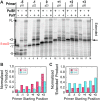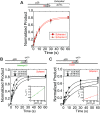A hand-off of DNA between archaeal polymerases allows high-fidelity replication to resume at a discrete intermediate three bases past 8-oxoguanine
- PMID: 32997110
- PMCID: PMC7641752
- DOI: 10.1093/nar/gkaa803
A hand-off of DNA between archaeal polymerases allows high-fidelity replication to resume at a discrete intermediate three bases past 8-oxoguanine
Abstract
During DNA replication, the presence of 8-oxoguanine (8-oxoG) lesions in the template strand cause the high-fidelity (HiFi) DNA polymerase (Pol) to stall. An early response to 8-oxoG lesions involves 'on-the-fly' translesion synthesis (TLS), in which a specialized TLS Pol is recruited and replaces the stalled HiFi Pol for lesion bypass. The length of TLS must be long enough for effective bypass, but it must also be regulated to minimize replication errors by the TLS Pol. The exact position where the TLS Pol ends and the HiFi Pol resumes (i.e. the length of the TLS patch) has not been described. We use steady-state and pre-steady-state kinetic assays to characterize lesion bypass intermediates formed by different archaeal polymerase holoenzyme complexes that include PCNA123 and RFC. After bypass of 8-oxoG by TLS PolY, products accumulate at the template position three base pairs beyond the lesion. PolY is catalytically poor for subsequent extension from this +3 position beyond 8-oxoG, but this inefficiency is overcome by rapid extension of HiFi PolB1. The reciprocation of Pol activities at this intermediate indicates a defined position where TLS Pol extension is limited and where the DNA substrate is handed back to the HiFi Pol after bypass of 8-oxoG.
© The Author(s) 2020. Published by Oxford University Press on behalf of Nucleic Acids Research.
Figures







Similar articles
-
Kinetic basis for the differing response to an oxidative lesion by a replicative and a lesion bypass DNA polymerase from Sulfolobus solfataricus.Biochemistry. 2012 Apr 24;51(16):3485-96. doi: 10.1021/bi300246r. Epub 2012 Apr 10. Biochemistry. 2012. PMID: 22471521
-
Mutagenic Bypass of an Oxidized Abasic Lesion-Induced DNA Interstrand Cross-Link Analogue by Human Translesion Synthesis DNA Polymerases.Biochemistry. 2015 Dec 22;54(50):7409-22. doi: 10.1021/acs.biochem.5b01027. Epub 2015 Dec 14. Biochemistry. 2015. PMID: 26626537 Free PMC article.
-
Biochemical analysis of DNA polymerase η fidelity in the presence of replication protein A.PLoS One. 2014 May 13;9(5):e97382. doi: 10.1371/journal.pone.0097382. eCollection 2014. PLoS One. 2014. PMID: 24824831 Free PMC article.
-
Filling gaps in translesion DNA synthesis in human cells.Mutat Res Genet Toxicol Environ Mutagen. 2018 Dec;836(Pt B):127-142. doi: 10.1016/j.mrgentox.2018.02.004. Epub 2018 Feb 23. Mutat Res Genet Toxicol Environ Mutagen. 2018. PMID: 30442338 Review.
-
Polymerase Delta in Eukaryotes: How is It Transiently Exchanged with Specialized DNA Polymerases During Translesion DNA Synthesis?Curr Protein Pept Sci. 2018;19(8):790-804. doi: 10.2174/1389203719666180430155625. Curr Protein Pept Sci. 2018. PMID: 29708067 Review.
Cited by
-
DNA Polymerase B1 Binding Protein 1 Is Important for DNA Repair by Holoenzyme PolB1 in the Extremely Thermophilic Crenarchaeon Sulfolobus acidocaldarius.Microorganisms. 2021 Feb 20;9(2):439. doi: 10.3390/microorganisms9020439. Microorganisms. 2021. PMID: 33672533 Free PMC article.
-
Beyond the Lesion: Back to High Fidelity DNA Synthesis.Front Mol Biosci. 2022 Jan 5;8:811540. doi: 10.3389/fmolb.2021.811540. eCollection 2021. Front Mol Biosci. 2022. PMID: 35071328 Free PMC article. Review.
-
Haloferax volcanii-a model archaeon for studying DNA replication and repair.Open Biol. 2020 Dec;10(12):200293. doi: 10.1098/rsob.200293. Epub 2020 Dec 2. Open Biol. 2020. PMID: 33259746 Free PMC article. Review.
-
Enzymatic Switching Between Archaeal DNA Polymerases Facilitates Abasic Site Bypass.Front Microbiol. 2021 Dec 20;12:802670. doi: 10.3389/fmicb.2021.802670. eCollection 2021. Front Microbiol. 2021. PMID: 34987494 Free PMC article.
-
Strand-resolved mutagenicity of DNA damage and repair.Nature. 2024 Jun;630(8017):744-751. doi: 10.1038/s41586-024-07490-1. Epub 2024 Jun 12. Nature. 2024. PMID: 38867042 Free PMC article.
References
-
- Kunkel T.A. DNA replication fidelity. J. Biol. Chem. 2004; 279:16895–16898. - PubMed
-
- Mouron S., Rodriguez-Acebes S., Martinez-Jimenez M.I., Garcia-Gomez S., Chocron S., Blanco L., Mendez J.. Repriming of DNA synthesis at stalled replication forks by human PrimPol. Nat. Struct. Mol. Biol. 2013; 20:1383–1389. - PubMed
Publication types
MeSH terms
Substances
LinkOut - more resources
Full Text Sources
Miscellaneous

